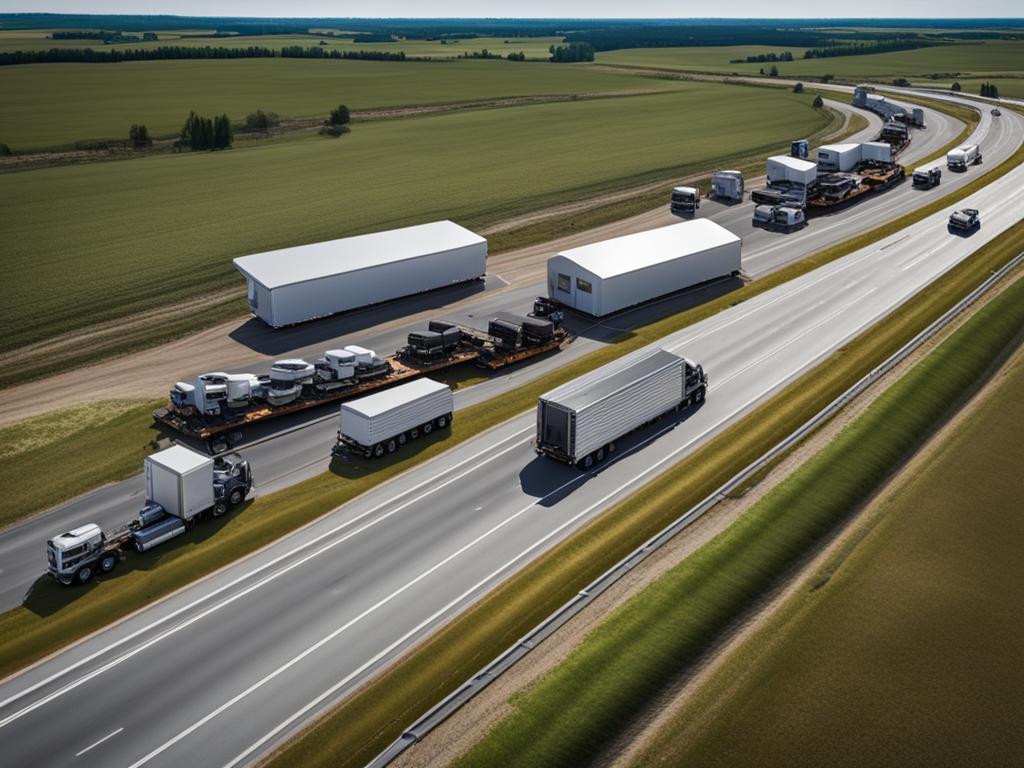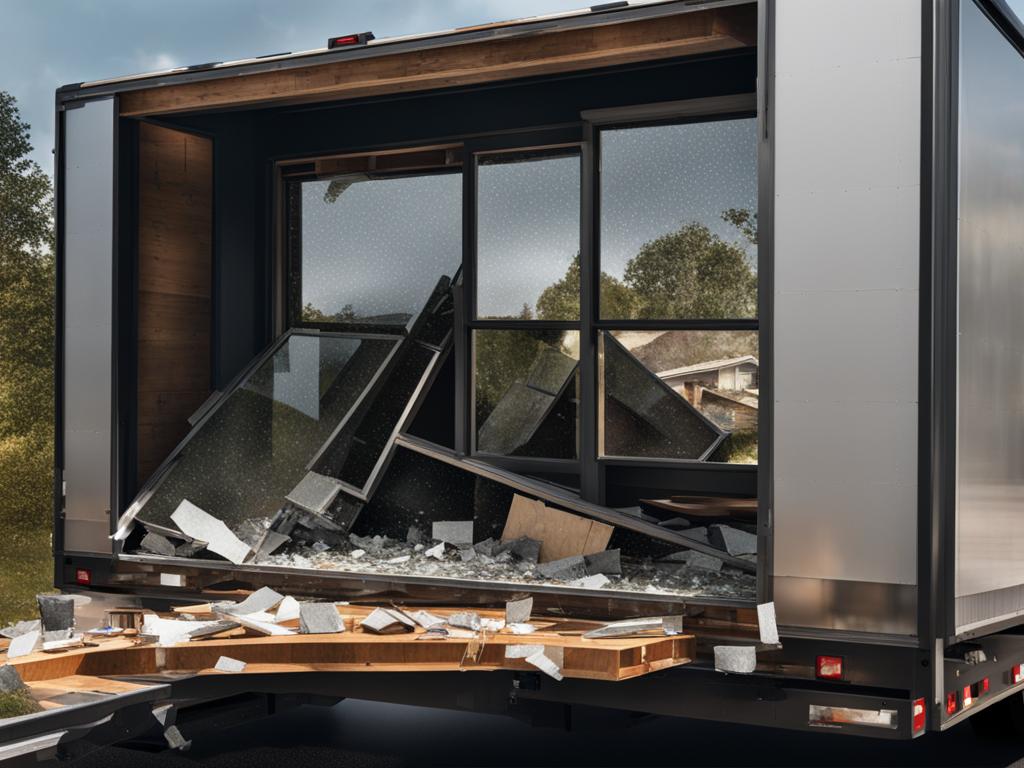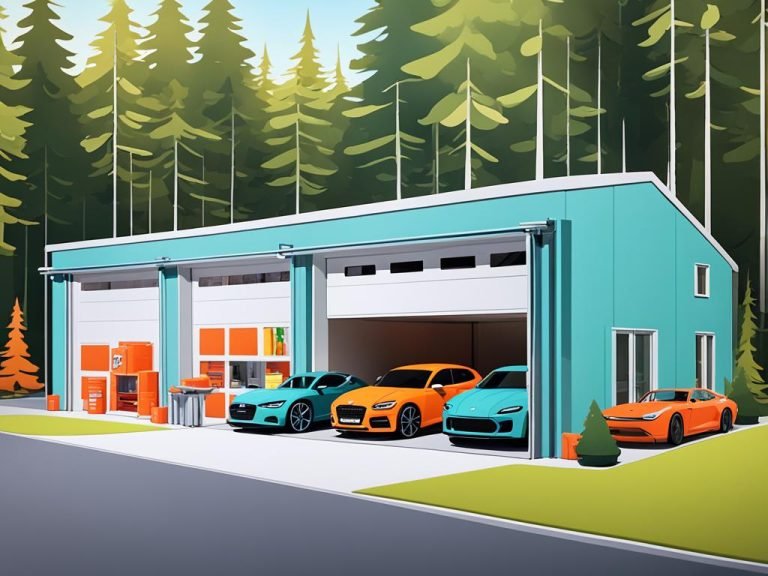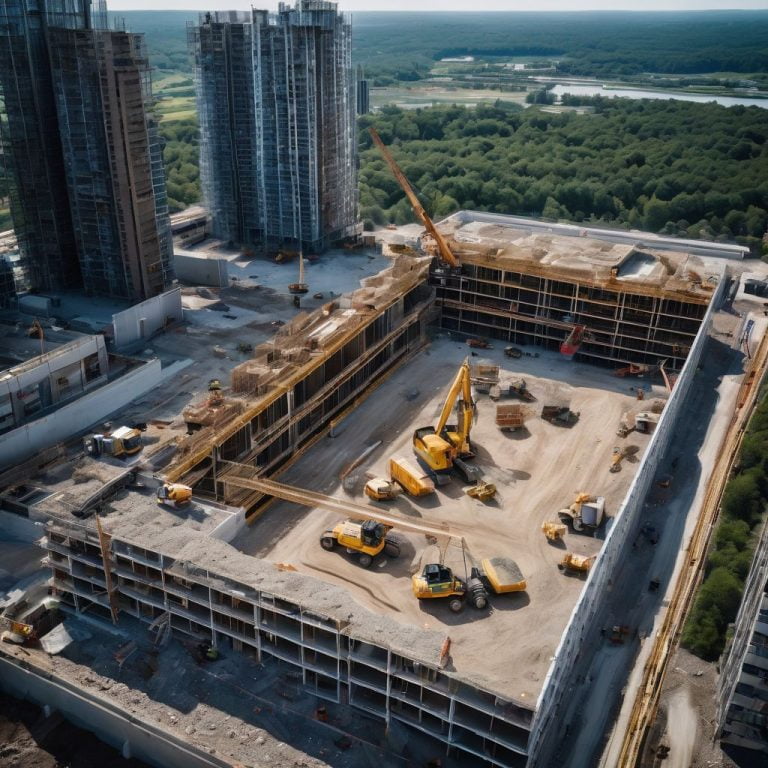Modular Home Transport: Logistics Explained

Transporting modular homes involves careful logistics to ensure safe and efficient delivery. The process can be impacted by various factors, such as environmental damage and impact damage. Environmental damage can occur from exposure to rain, dew, and changes in temperature, leading to unnoticed damage to the modular units. On the other hand, impact damage can be caused by accidents during transportation, resulting in cracks or breakages. It’s essential to have proper route planning and tracking systems, like GPS trackers, to mitigate these risks and improve supply chain visibility.
Key Takeaways:
- Transporting modular homes requires careful logistics planning to ensure safe and efficient delivery.
- Environmental damage from rain, dew, and temperature changes can go unnoticed but cause significant harm to the modular units.
- Impact damage during transportation can lead to cracks and breakages, resulting in unusable homes and added rework time.
- GPS tracking systems provide enhanced visibility and real-time insights to prevent damage and improve supply chain efficiency.
- Efficient transport requires planning, coordination, specialized equipment, and permits, as well as collaboration between manufacturers and logistics partners.
Impact Damage during Modular Home Transport
During the transport of modular homes, impact damage can have a significant impact on the overall condition and integrity of the units. This type of damage occurs when the modular units shift or move unexpectedly, often as a result of encountering potholes or experiencing sudden braking during transit.
One common consequence of impact damage is the development of hairline cracks in the structure of the modular homes. These cracks can compromise the stability and durability of the units, potentially rendering them unusable. In addition, impact damage can also result in twisting or bending of the frames, further exacerbating the structural issues.
Unfortunately, impact damage during transport is not always immediately noticeable. It often goes undetected until the units have been delivered and installed at the intended site. This can result in delays and added rework time for both manufacturers and clients, as damaged units may need to be repaired or replaced before they can be used.
Poor route planning and navigation can contribute to impact damage during modular home transport. Narrow roads, low bridges, and built-up areas pose challenges for the safe transportation of these large units. Maneuvering through such obstacles can increase the risk of external damage to the modular homes and potentially disrupt the overall supply chain.
The Structure of Modular Homes
Modular homes, also known as prefabricated or factory-built homes, are constructed in sections or modules in a controlled factory environment. These modules are then transported to the intended site for final assembly and installation. The structure of modular homes is designed to withstand the rigors of transportation and provide a sturdy and reliable living space.
Modular homes typically consist of a steel or wooden frame, which forms the structural skeleton of the units. This frame provides stability and support for the various components of the home, including walls, floors, and roofs. It is essential for the frame to remain intact and undamaged during transport to maintain the structural integrity of the modular home.
Exterior damage to the modular homes, resulting from impact during transport, can compromise not only the aesthetics but also the functionality and durability of the units. Cracks, dents, or other types of exterior damage can lead to water leakage, reduced insulation, and overall decreased performance of the modular home.

Efforts must be made to minimize impact damage during modular home transport to ensure that these prefabricated units arrive at their destination in excellent condition. This not only preserves the investment made by clients but also streamlines the construction process and reduces additional costs for manufacturers.
Environmental Damage during Modular Home Transport
Transporting modular homes involves various challenges, including the risk of environmental damage. Rain and dew can pose significant threats to the integrity of these structures, potentially leading to water damage. When exposed to rainfall, especially near the junctions of different sections, modular homes can sustain rain damage.
To mitigate this risk, protective measures such as tarpaulin or cling-film wraps are often employed. However, despite these precautions, coverings can tear or be lost during transport, leaving the units exposed to the elements.
One issue that arises from the use of tarpaulin or cling-film wraps is the potential for dew formation underneath. As the temperature changes underneath the coverings, moisture can accumulate, increasing the risk of water damage to the modular homes. This damage may not be immediately visible, making it crucial to take preventive measures to avoid long-term harm.

Efficient strategies for protecting modular homes from environmental damage during transport are of utmost importance. Addressing the risks associated with rain and dew by ensuring reliable tarpaulin protection and implementing suitable measures to prevent invisible water damage can help safeguard the structural integrity of these prefabricated dwellings.
GPS Tracking for Improved Visibility and Monitoring
To address the challenges of modular home transport, GPS tracking systems like Pathfindr’s can provide enhanced visibility throughout the transportation process. These trackers, attached to the homes and transporters, gather data on location, environmental factors (such as temperature and dew point), impact events, and motion.
This comprehensive dataset allows manufacturers and clients to monitor and track the journey of modular homes, enabling them to identify potential risks and collaborate more effectively. With real-time insights provided by GPS tracking, manufacturers and clients can work together to prevent damage and improve overall supply chain efficiency.
By utilizing location tracking capabilities, manufacturers can accurately monitor the movements of modular homes and ensure on-time delivery. Environmental monitoring features allow them to keep a close eye on factors such as temperature and dew point, helping to prevent potential damage caused by extreme weather conditions. Impact detection helps identify any accidents or collisions during transportation, enabling immediate action to minimize damage. The collection of motion data provides valuable insights into the movement patterns of the modular homes, enabling manufacturers to optimize their transportation processes further.
Moreover, GPS tracking systems facilitate route tracking, allowing manufacturers and clients to have visibility into the exact routes taken during transportation. This not only helps in planning the most efficient routes but also serves as a means of verifying that the modular homes are following pre-determined paths, avoiding potential risks such as bridges with low clearance or roads that are unsuitable for transportation.
- GPS tracking for modular homes enables enhanced location tracking throughout the transportation process.
- Environmental monitoring features provide real-time data on temperature and dew point to prevent potential damage.
- Impact detection capabilities help identify accidents and collisions during transportation.
- Motion data collection offers insights into the movement patterns of modular homes, optimizing transportation processes.
- Route tracking functionality ensures that modular homes follow the most efficient and safe routes.
By leveraging GPS tracking systems, manufacturers and clients can improve supply chain visibility and strengthen collaboration, creating a mutually beneficial relationship. Manufacturers can reduce the risk of damage during transportation, leading to cost savings and improved customer satisfaction. Clients, on the other hand, can gain peace of mind knowing they have accurate information on the status and location of their modular homes.
![]()
Planning and Sequencing for Efficient Transport
In order to ensure the smooth and efficient transport of modular homes, careful planning and sequencing are of utmost importance. By conducting site surveys, potential challenges can be identified and addressed proactively, preventing them from becoming major problems.
Logistics partners play a crucial role in this process, considering factors such as travel routes, truck capabilities, and permitting requirements. By carefully planning the most optimal transportation routes, potential delays and obstacles can be minimized, saving both time and resources.
In some cases, staging yards can be utilized to streamline the process. Staging yards act as temporary storage areas for modular homes, providing a centralized location for coordination and preparation before they are transported to their final destinations. However, it is important to note that staging yards may introduce additional risks and costs, and therefore their use should be carefully evaluated.
Effective coordination with the onsite construction crew is vital for successful modular home transport. By maintaining open communication channels and collaborating closely with the construction team, any potential issues or changes can be addressed promptly, ensuring a seamless workflow.
To further optimize the transportation process, innovative solutions like Transit Buffers™ can be employed. Transit Buffers™ provide extended delivery time without the need for a traditional storage yard, reducing costs and minimizing the risk of damage. These buffers act as temporary holding areas, allowing for flexibility in delivery schedules and accommodating any changes in onsite construction progress.
By employing strategic planning and sequencing, modular home manufacturers can enhance the efficiency of their transportation operations, minimizing disruptions and maximizing cost savings. This collaborative approach between logistics partners, construction crews, and innovative solutions fosters a streamlined and successful modular home delivery process.
Specialized Equipment and Permits for Modular Home Transport
Successfully transporting modular homes often requires specialized equipment and permits. Oversize loads, especially in terms of weight and width, may necessitate specific trucks and self-loading trailers. Logistics partners must be knowledgeable about federal and state laws governing the transportation of oversized freight and obtain the necessary permits. In some cases, pilot cars may be required for safe transport. It’s essential to work with experienced logistics teams who understand the logistics behind logistics and can navigate the complexities of modular home transport.
When it comes to oversize loads transport, having the right equipment is crucial. Specialized trucks specifically designed for oversized freight can accommodate the weight and dimensions of modular homes. These trucks often have reinforced frames, heavy-duty axles, and powerful engines to handle the load efficiently.
Self-loading trailers are another essential component in the transportation of modular homes. These trailers feature hydraulic systems that allow the homes to be loaded and unloaded without the need for additional equipment. This streamlined process improves efficiency and reduces the risk of damage during loading and unloading.
Transporting oversize loads also requires obtaining permits from federal and state authorities. Each jurisdiction has its own regulations and restrictions regarding the transport of oversized freight. These permits ensure compliance with legal requirements and help prevent delays and fines during transportation.
In certain scenarios, pilot cars may be necessary for safe and efficient transport. Pilot cars, also known as escort cars, accompany oversize loads to provide additional visibility and assistance on the road. They help navigate through traffic, warn of obstacles or hazards, and communicate with the truck driver to ensure a smooth journey.
It’s crucial to collaborate with experienced logistics teams who understand the intricacies of modular home transport. These professionals have in-depth knowledge of federal and state laws governing the transportation of oversize loads, ensuring compliance and avoiding legal issues. They also possess the expertise to select the appropriate equipment, obtain the necessary permits, and coordinate the logistics behind the scenes.

Overall, the successful transport of modular homes relies on specialized equipment, adherence to permits, and comprehensive knowledge of federal and state laws. By working with experienced logistics teams, manufacturers and clients can ensure the safe and efficient delivery of modular homes.
Delivery Sequence and Transit Buffers for Efficient Transport
Developing a delivery sequence plan is critical for efficient modular home transport. Coordinating the flow of trucks and deliveries to align with the onsite crew’s needs ensures smooth progress. It involves careful planning and coordination to ensure that each modular unit is delivered to the job site in the right order, optimizing the construction process.
To achieve this, having a dedicated project manager overseeing the entire delivery process is essential. The project manager acts as a point of contact and coordinates with all stakeholders involved, including the manufacturer, logistics partners, and the onsite construction crew. Their role is to ensure communication and adaptability throughout the delivery process, addressing any potential issues or delays that may arise.
Transit Buffers™ provide a valuable solution when the warehouse needs to release modular units before the job site is ready. These buffers create a flexible and extended delivery time frame without the need for a storage yard, minimizing costs and reducing the risk of damage to the units. Transit Buffers™ can be used to hold the modular homes in a secure and controlled environment, ensuring they are ready for delivery when the job site is prepared.

In addition to serving as buffer zones, Transit Buffers™ offer other benefits. They allow for early delivery options, which can be advantageous if the construction crew progresses ahead of schedule. Early delivery can lead to faster completion times and increased customer satisfaction. Furthermore, Transit Buffers™ provide alternatives to traditional storage yards, eliminating the need for additional space and the associated costs.
- Delivery sequence planning
- Onsite crew coordination
- Dedicated project manager
- Transit Buffers™
- Storage yard alternatives
- Buffer benefits
- Early delivery options
By implementing proper delivery sequence planning, coordinating with the onsite crew, and utilizing Transit Buffers™, modular home transport can be optimized for efficiency and cost-effectiveness. The collaborative efforts of all parties involved, combined with these innovative solutions, contribute to successful and timely delivery of modular homes.
Conclusion
Efficient modular home transport relies on comprehensive logistics planning and coordination. The transport process presents challenges, such as impact and environmental damage, which can be mitigated through innovative solutions like GPS tracking and improved visibility.
Careful planning, sequencing, and the consideration of specialized equipment and permits are crucial in optimizing the transport process. By leveraging these strategies, manufacturers and logistics partners can ensure the safe and timely delivery of modular homes.
Transit Buffers™ provide flexibility and cost savings by allowing for extended delivery time without the need for a storage yard. This innovative solution reduces costs and minimizes the potential for damage. Furthermore, collaboration between manufacturers, logistics partners, and onsite crews is essential for successful modular home delivery.
By working together, leveraging advanced technologies, and implementing efficient logistics strategies, the modular home industry can overcome challenges and achieve seamless transportation, ensuring the timely delivery of high-quality homes to meet the growing demands of the market.
FAQ
How are modular homes transported?
Modular homes are transported using specialized trucks and trailers. They are typically built in sections at a factory and then transported to the site for assembly. The sections are loaded onto trailers and secured for safe transportation.
What are the transportation methods used for modular homes?
Modular homes are transported using various methods, including flatbed trucks, self-loading trailers, and oversize load transportation. The specific method depends on the size and weight of the modular units and the regulations governing transport.
How is the delivery process of modular homes planned?
The delivery process of modular homes involves careful planning and coordination. Site surveys are conducted to identify any challenges, and logistics partners consider factors such as travel routes, truck capabilities, and permitting requirements to ensure a smooth transportation process.
What are the risks of impact damage during modular home transport?
Impact damage can occur during modular home transport due to shifting of the units on the back of a truck. This can lead to hairline cracks and twisting of frames, which may go unnoticed until the units are delivered. Poor route planning with narrow roads and low bridges can also contribute to exterior damage and supply chain disruption.
How does environmental damage occur during modular home transport?
Environmental damage can occur during modular home transport due to exposure to rain, dew, and changes in temperature. Rain can cause damage to exposed areas of the modular units, and dew formation under tarpaulin covers can lead to moisture accumulation and water damage. These damages may not be immediately visible but can cause significant harm if left untreated.
What is the importance of GPS tracking in modular home transport?
GPS tracking systems provide enhanced visibility throughout the transportation process. These trackers gather data on location, environmental factors, impact events, and motion, allowing manufacturers and clients to track the journey, monitor potential risks, and collaborate more effectively. Real-time insights help prevent damage and improve supply chain efficiency.
How can planning and sequencing optimize modular home transport?
Planning and sequencing are crucial for efficient modular home transport. Site surveys help identify and address challenges before they become problems. Coordinating the flow of trucks and deliveries with the onsite crew’s needs ensures smooth progress. Solutions like staging yards and Transit Buffers™ can also optimize the transportation process and streamline delivery.
What specialized equipment and permits are required for modular home transport?
Transporting modular homes often requires specialized trucks and self-loading trailers due to their weight and size. Logistics partners must obtain permits and comply with federal and state laws governing the transportation of oversized freight. In some cases, pilot cars may be required to ensure safe transport.






